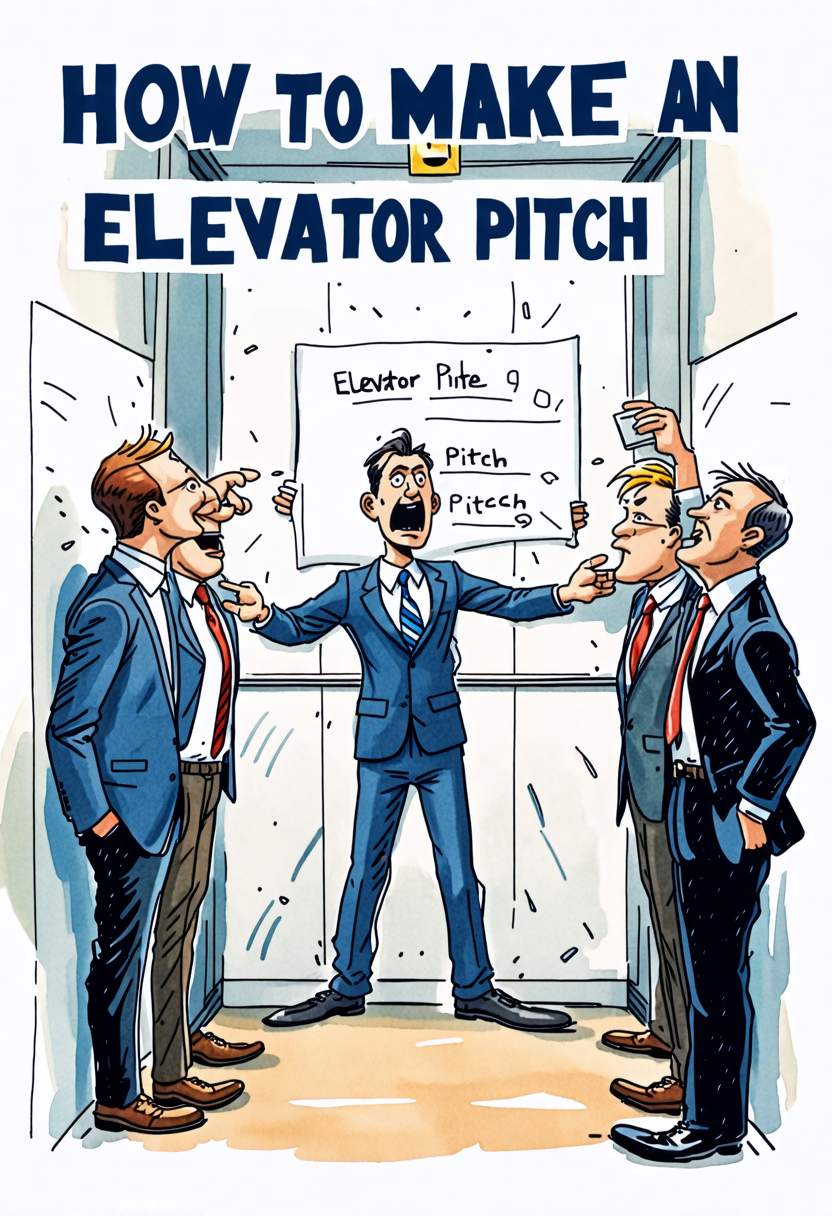How to Make an Elevator Pitch?
To craft an elevator pitch, start with a strong opening to grab attention. Clearly explain your value and what you offer. Wrap up with a call to action. Brainstorm your skills and unique experiences. Then, refine your message to be clear and concise without jargon. Practice your pitch often, in front of a mirror or with friends, to guarantee smooth delivery. For instance, in a job interview, you might say, ‘Hi, I’m Alex. I’ve got 5 years in digital marketing and excel at boosting online engagement.’
Elevator Pitch Overview
An elevator pitch is a brief and powerful summary of who you’re and what you offer. It lasts between 30-60 seconds. You’ll use it to introduce yourself professionally during job interviews, sales calls, or networking events. The goal is to spark interest and start a more detailed conversation.
Crafting an effective elevator pitch involves condensing your introduction, goals, and value into a few sentences. Think about what makes you unique and what you bring to the table. Then, edit for clarity and brevity. Practice your pitch aloud until it feels natural.
Using an elevator pitch can reduce nervousness and boost your confidence. It helps you communicate your message effectively and opens up new opportunities in various professional situations.
Key Components
Understanding the key components of an elevator pitch helps you craft a compelling and memorable introduction.
First, start with a strong opening that grabs attention. This could be a unique fact or a relevant question.
Next, clearly convey your value proposition—what you offer and why it matters.
Finally, end with a call to action, prompting your listener to take the next step.
Here are the key components succinctly presented:
- Opening: Capture interest immediately.
- Value Proposition: State your unique benefits.
- Call to Action: Encourage further engagement.
Brainstorming Ideas
Start brainstorming ideas by listing your skills, experiences, and what makes you unique.
Think about your career highlights and the problems you’ve solved.
Consider any special training or awards you’ve received.
Write these down in bullet points to see everything clearly.
Next, think about the goals you want to achieve with your pitch.
Are you looking for a new job, a partnership, or to sell an idea?
Knowing your goal helps shape your message.
Identify what makes you stand out.
It could be your unique approach, a specific skill, or a standout accomplishment.
This will be your hook to grab attention.

Editing for Brevity
Refine your elevator pitch to make sure every word adds value and keeps the message clear.
Start by removing any fluff or redundant phrases.
Each sentence should highlight your key points without wasting time.
Aim for a concise, powerful delivery.
Cut unnecessary words: Use simple, direct language.
Focus on key points: Stick to your main message.
Eliminate jargon: Keep it understandable for all audiences.
Read your pitch aloud and see where you can trim.
This helps guarantee your message is smooth and impactful.
Remember, your goal is to engage quickly and leave a lasting impression.
With a polished, concise pitch, you’ll stand out in any professional setting.
Practicing Your Pitch
Once you’ve edited your pitch for brevity, it’s time to practice delivering it smoothly. Start by practicing in front of a mirror. This helps you see your facial expressions and body language.
Next, try recording yourself. Listen to your tone and pace. Are you speaking too fast or too slow?
Then, practice with a friend or family member. Get their feedback. Ask if your message is clear and if you sound confident.
Repeat this process until you feel comfortable.
Benefits of an Elevator Pitch
An elevator pitch can boost your confidence and help you communicate effectively. When you’ve got a clear, concise pitch ready, you’ll feel more prepared in various situations. This preparation reduces nervousness and makes it easier to convey your message.
Here are some benefits of having an elevator pitch:
- Clarity: You’ll present your ideas clearly and succinctly.
- Confidence: Knowing your pitch inside out builds self-assurance.
- Opportunities: It opens doors for further conversations and potential collaborations.
Effective Usage Scenarios
You’ll find that elevator pitches are perfect for a variety of professional scenarios. In job interviews, they help you make a strong first impression.
At networking events, they can quickly introduce you to potential connections.
During sales calls, you can grab the client’s attention right away.
If you’re fundraising, a sharp pitch can attract investors.
Even casual conversations can turn into opportunities when you have a well-prepared pitch.
Anytime you need to convey your value quickly and clearly, an elevator pitch is your best tool. It guarantees you’re always ready to present yourself professionally and effectively.
Best Practices
To make your elevator pitch effective, focus on keeping it clear, concise, and tailored to your audience. Start by avoiding excessive jargon and maintaining a conversational tone. Speak at a moderate pace to guarantee your message is understood. Adapt your pitch based on who you’re talking to.
Here are three best practices:
- Be Authentic: Show genuine interest and passion in what you’re pitching.
- Highlight Value: Emphasize what sets you or your idea apart.
- Practice Regularly: Rehearse to sound natural and confident.
Regularly update your pitch for relevance. Stay aware of current trends and industry-specific language that may resonate with your audience. This guarantees your pitch remains fresh and impactful.
Types of Elevator Pitches
Knowing the best practices is great, but let’s explore the various types of elevator pitches you can use.
First, there’s the interview pitch, where you introduce yourself and highlight your skills.
Then, there’s the persuasive pitch, which aims to convince your listener to take action.
The business pitch focuses on your company’s value and goals.
A statistical pitch uses compelling data to make a point.
Lastly, the origin story pitch shares a personal or company background to build a connection.
Each type has a specific use, so choose the one that fits your situation best.
Practice and tailor your pitch to make it impactful and relevant to your audience.
Real-Life Examples
Let’s look at some real-life examples of effective elevator pitches. These examples will help you understand how to craft your own pitch and make a strong impression.
- Job Interview:
‘Hi, I’m Alex. I’ve five years’ experience in digital marketing. I helped my last company increase their online sales by 30% in one year. I’m excited about the opportunity to bring my skills to your team.’
- Networking Event:
‘Hi, I’m Jamie. I run a startup that develops eco-friendly packaging. We’ve already partnered with major retailers and reduced plastic waste by 20%. I’d love to discuss how we could collaborate.’
- Sales Call:
‘Hello, I’m Taylor. Our software boosts productivity by automating routine tasks. Companies using it have seen a 40% increase in efficiency. Can we explore how it can help your business?’
Frequently Asked Questions
How Do I Handle Interruptions During My Elevator Pitch?
If you’re interrupted during your elevator pitch, stay calm. Listen to the interruption, address it briefly, then steer the conversation back to your pitch. Practice handling interruptions to maintain confidence and flow.
What Should I Do if the Listener Seems Uninterested?
If the listener seems uninterested, try to engage them by asking a question. Adjust your pitch to highlight something relevant to them. If they’re still disengaged, politely wrap up and thank them for their time.
How Can I Incorporate Feedback to Improve My Pitch?
Listen carefully to the feedback you receive. Identify common points or suggestions. Adjust your pitch to address these areas. Practice the revised version until it flows naturally. Always stay open to continuous improvement and refinement.
Should I Use Visual Aids During My Elevator Pitch?
You can use visual aids in your elevator pitch if they enhance your message. Keep them simple and relevant. Visuals should support your words, not distract. Practice using them smoothly to make sure they add value.
How Do I Adjust My Pitch for Virtual Meetings or Calls?
Adjust your pitch for virtual meetings by ensuring strong internet connection and clear audio. Look directly at the camera to maintain eye contact. Use concise language, engage actively, and adapt your pitch to suit the virtual format.







